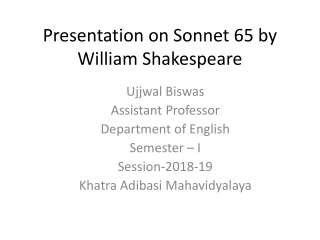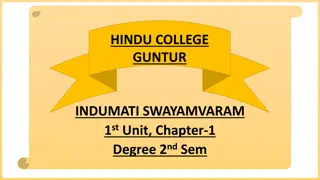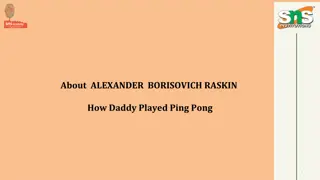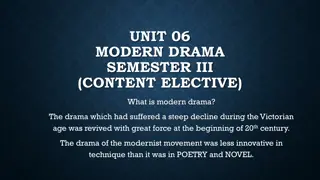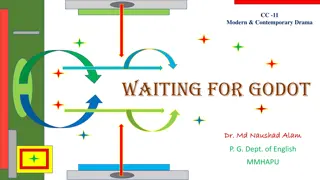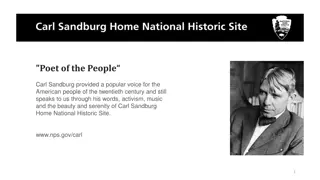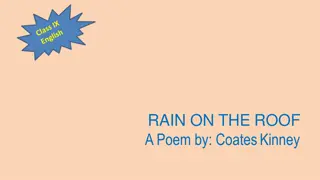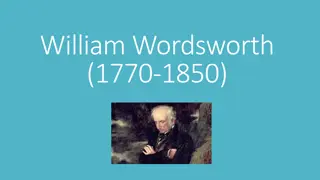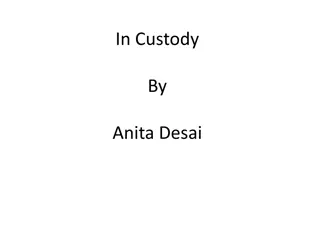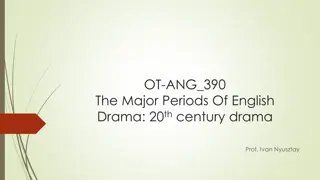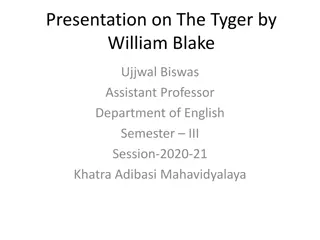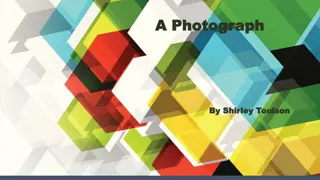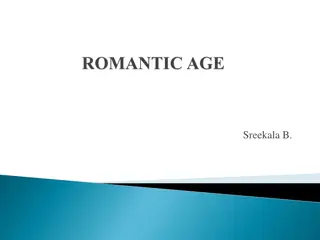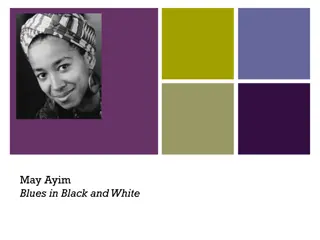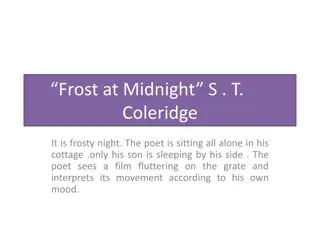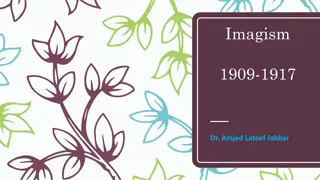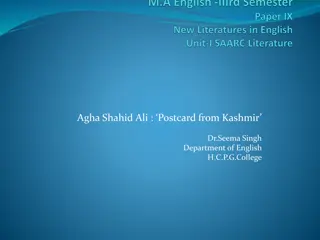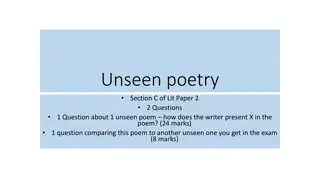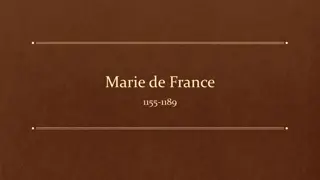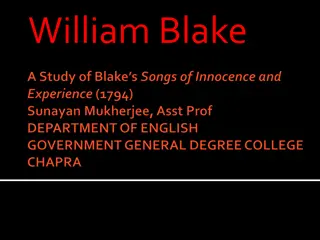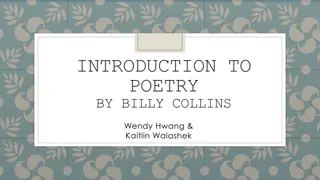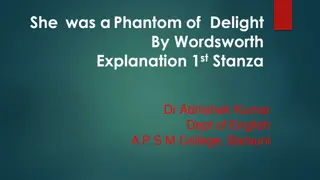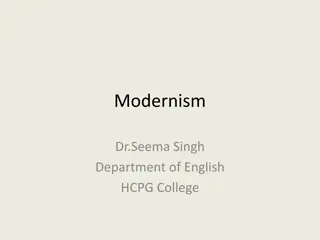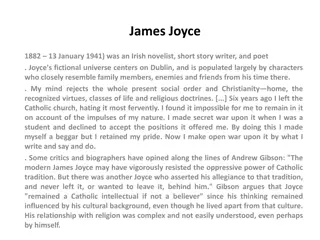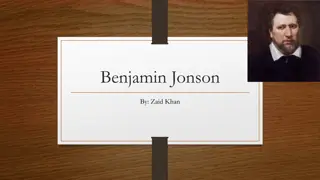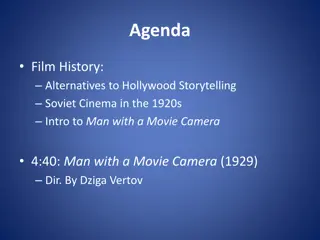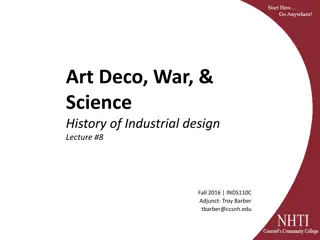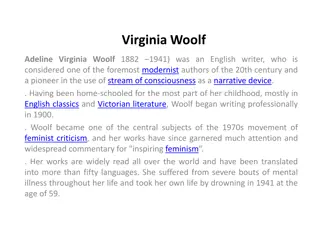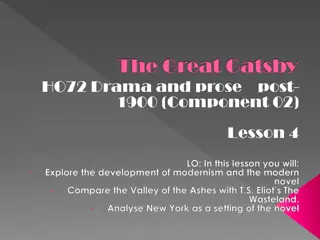Analysis of Sonnet 65 by William Shakespeare
Sonnet 65 by William Shakespeare explores the theme of Time as a powerful force that defies all earthly materials. The poet contemplates how beauty, no matter how strong, will ultimately succumb to Time's relentless passage. The sonnet delves into the idea of immortality through poetry, suggesting t
0 views • 6 slides
Biography of Michael Madhusudan Dutt: A Poet's Journey from Europe to Bengal
Explore the fascinating life of Michael Madhusudan Dutt, a renowned 19th-century Bangalee poet and dramatist. Born in Sagordari, he initially aspired to be English in form and manner, embracing Christianity and traveling to Europe to compose English poems and plays. Despite initial setbacks, he foun
1 views • 8 slides
Biography and Works of Kalidasa: The Great Poet of Ancient India
Kalidasa, the revered poet of ancient India, is celebrated for his significant contributions to Sanskrit literature. Known for works like "Abhignana Sakuntalam" and "Raghuvamsam," Kalidasa's life and poetic genius continue to inspire scholars and enthusiasts alike. This biography explores his origin
5 views • 16 slides
Insight into Alexander Borisovich Raskin: Writer, Poet, and Ping Pong Enthusiast
Russian writer and poet Alexander Borisovich Raskin, known for his humorous and satirical works, became famous for his book "When Daddy was a Little Boy." The story "How Daddy Played Ping Pong" showcases his talent and wit. Learn about his life, literary contributions, and why table tennis is called
0 views • 8 slides
Ernest Hemingway: Iconic Writer of the Lost Generation
Ernest Miller Hemingway, born in Oak Park, Illinois, was a prominent writer of the Lost Generation. His experiences in World War I influenced his writing style, marked by simplicity and objectivity. Moving to Paris, he mingled with Modernist artists and revolutionized American fiction. The Lost Gene
2 views • 24 slides
Evolution of Modern Poetry in the 20th Century
Modern poetry in English emerged in the early 20th century as a reaction to Victorian formalism. Modernists drew inspiration from diverse literary traditions, including Greek, Chinese, and Japanese poetry, to create works that depicted social changes and the impact of World War I. Themes of material
1 views • 7 slides
Exploring Modern Drama: History and Characteristics
Modern drama, revived in the early 20th century after a decline in the Victorian age, encompasses realism, plays of ideas, romanticism, and poetic elements. English drama during the modernist period is categorized into phases marked by influential playwrights like Henrik Ibsen, G.B. Shaw, T.S. Eliot
0 views • 9 slides
Understanding Samuel Beckett's Waiting for Godot: A Modernist Masterpiece
Samuel Beckett, a prominent modernist writer, crafted the groundbreaking play "Waiting for Godot" as a tragicomedy in a theater of the absurd. Set in a vague time and place, the play reflects the post-World War II disillusionment and existential themes. Beckett's experimental approach challenges tra
1 views • 16 slides
Carl Sandburg: Poet of the People and Biographer of Lincoln
Explore the legacy of Carl Sandburg, the Poet of the People in the 20th century, through his words, activism, and music. Discover his tribute to Abraham Lincoln and his biographical works. Dive into Sandburg's captivating storytelling of Lincoln's childhood and upbringing, reflecting on how he shape
0 views • 7 slides
Appreciating the Healing Power of Rain in "Rain on the Roof" by Coates Kinney
The poem "Rain on the Roof" by Coates Kinney explores the poet's emotional response to the sound of raindrops on his rooftop. It delves into themes of nostalgia, comfort, and the ability of rain to evoke cherished memories, particularly of the poet's mother, offering solace in its soothing rhythm. T
1 views • 15 slides
William Wordsworth (1770-1850): Poet of Nature and Memory
William Wordsworth, a renowned English poet, was born in 1770 and his works were inspired by the landscapes of the Lake District. His collaboration with Coleridge in publishing "Lyrical Ballads" marked a significant moment in Romantic poetry. Wordsworth's emphasis on simplicity, nature, memory, and
0 views • 7 slides
In Custody: A Story of Identity and Redemption
In Anita Desai's novel "In Custody," protagonist Deven Sharma grapples with feelings of failure and dissatisfaction as he navigates his unfulfilled dreams of becoming a renowned Urdu poet. When presented with the opportunity to interview his idol, Urdu poet Nur Shahjehanabadi, Deven sees a chance to
7 views • 17 slides
Evolution of English Drama in the 20th Century: Shaw, Ibsen, and Modernist Theatre
The 20th century English drama witnessed significant shifts, from the realism and naturalism of George Bernard Shaw and Ibsen to the modernist theatre of Samuel Beckett, Tom Stoppard, and Harold Pinter. Themes of social change, rejection of traditional ideals, and a focus on human experiences domina
0 views • 39 slides
Exploring "The Tyger" by William Blake: An Insight into the Poet's Vision
William Blake, a visionary poet and artist, crafted "The Tyger" as a thought-provoking piece questioning the nature of creation and the duality of existence. Through rhetorical questions and literary devices, Blake delves into the mystery of the fierce beast and reflects on themes of divine power an
0 views • 7 slides
Recollection Through A Photograph: Shirley Toulson's Poetic Tribute
The poem "A Photograph" by Shirley Toulson is a nostalgic reflection on the poet's mother through an old photograph. Toulson vividly recalls the image of her mother and her cousins on a beach holiday, capturing a moment frozen in time. The poem beautifully expresses the enduring impact of memories a
0 views • 8 slides
The Romantic Poet William Wordsworth: Life, Works, and Influence
William Wordsworth, a prominent Romantic poet, was known for his connection to nature, emphasis on individualism, and rejection of industrialization. This summary discusses his life, notable works like "Lyrical Ballads," and his impact on the Romantic Movement.
1 views • 18 slides
Analysis of "Crossing the Bar" by Alfred Lord Tennyson
The poem "Crossing the Bar" by Alfred Lord Tennyson is written in quatrains, with each stanza of 4 lines rhyming abab, cdcd, efef, ghgh. The poet contemplates the journey from life to death, symbolized by crossing a sand bar. Through the sunset, tide, stages of life, and evening bell, the poet expre
0 views • 5 slides
Analyzing "Icarus Flight" Through SOAPSTONE Approach
Analysis of the myth of Icarus and Daedalus through the SOAPSTONE method, focusing on the poet's perspective, stylistic elements, tone, organization, and narrative style in the poem. The poet questions Icarus' actions to prompt a deeper understanding of the consequences of flying too close to the su
0 views • 6 slides
Biography and Impact of May Ayim: A Trailblazing Afro-German Poet
May Ayim, a pioneering Afro-German poet, left a lasting impact on German literature and society. Born in 1960 in Hamburg, she co-founded the Initiative Schwarze Deutsche, contributed to the feminist movement, and published notable works like "Blues in Black and White." Despite her tragic suicide in
0 views • 11 slides
Analysis of "Frost at Midnight" by S.T. Coleridge
In "Frost at Midnight," S.T. Coleridge explores themes of solitude, nature, and self-reflection. The poem depicts the poet sitting alone in his cottage on a frosty night, finding affinity with a film fluttering on the grate. The analysis delves into the poet's contemplation of loneliness, the stilln
2 views • 9 slides
Imagism: A Brief Overview of a Modernist Poetry Movement
Imagism was a poetic movement that flourished in Britain and the United States between 1909 and 1917, aiming to break away from the sentimentality of Victorian poetry. Influenced by French symbolists and Japanese haiku, imagist poets like Ezra Pound and Amy Lowell focused on creating concise, vivid
3 views • 21 slides
Analysis of George Herbert's Poem "The Collar" and the Poet's Background
George Herbert's poem "The Collar" published in 1633 depicts a man experiencing a loss of faith and anger over his commitment to God. The themes include struggles with beliefs and desire for autonomy. Herbert was a Welsh-born poet, orator, and priest known for his pure language choices and devotion.
0 views • 8 slides
Life and Legacy of Jalal ad-Din al-Rumi: A 13th-Century Persian Poet and Sufi Mystic
Rumi, born in 1207 in present-day Afghanistan, was a renowned Persian poet, scholar, and Sufi mystic. His works, primarily in Persian, have transcended borders and ethnic divisions, captivating audiences across centuries. Rumi's spiritual journey, from scholarly pursuits to mystical encounters with
0 views • 15 slides
Reflections on Kashmir - A Poetic Journey of Longing and Nostalgia
The poem "Postcard from Kashmir" by Agha Shahid Ali beautifully captures the emotions of longing and nostalgia for one's homeland. Through vivid imagery and poignant words, the poet reflects on the bittersweet memories of Kashmir, contrasting the idealized past with the harsh realities of the presen
0 views • 8 slides
Unseen Poetry Analysis: Winter Reflections in "Hard Frost" by Andrew Young
Explore the reflective nature of winter in Andrew Young's "Hard Frost" where the poet depicts the harshness and beauty of the season through vivid imagery and personification, highlighting the temporary nature of winter in the face of the impending arrival of summer. Analyze the portrayal of winter
0 views • 17 slides
Marie de France: The Earliest Female Poet in France
Earliest female poet in France, Marie de France (1155-1189), was educated in the Normandy area by Henry II. She is known for her works such as the Lais, Ysopet, and Espurgatoire de Saint Patrice, showcasing her talent in translating and storytelling. Her lais are characterized by adventure, romance,
1 views • 9 slides
William Blake: Visionary Artist and Poet of the Romantic Movement
William Blake, an iconic figure in the Romantic Movement, was a visionary artist and poet known for works like "Songs of Innocence" and "Songs of Experience." His imaginative and prophetic books reflected a break from the Enlightenment philosophy, emphasizing emotion over rationality. Inspired by th
0 views • 27 slides
Exploring Poetry Through Imagery and Tone in Billy Collins' Work
Diving into Billy Collins' poem "Introduction to Poetry," this analysis delves into the use of imagery, figurative language, tone, and style to convey the poet's frustration with how readers often approach poetry superficially. Collins encourages readers to immerse themselves in the emotional depth
0 views • 5 slides
Analysis of "She was a Phantom of Delight" by Wordsworth
The poem "She was a Phantom of Delight" by William Wordsworth portrays a woman as a delightful and enchanting figure, described with vivid imagery. The poet's admiration for her beauty and spirit is evident in the first stanza, where he compares her to a lovely apparition with eyes like stars and du
0 views • 8 slides
Key Figures of Modernism in Literature
Explore the prominent figures of Modernism in literature, including T.S. Eliot, W.B. Yeats, James Joyce, and Virginia Woolf. Discover their significant works that shaped the Modernist movement and revolutionized the literary world.
0 views • 15 slides
The Literary Universe of James Joyce
James Joyce, the renowned Irish novelist, short story writer, and poet, crafted a fictional realm centered around Dublin, populated by characters reflecting individuals from his past. His works, including "Dubliners" and "Ulysses", delve into themes of national identity, epiphanies, and intricate na
0 views • 5 slides
Benjamin Jonson: Playwright and Poet Extraordinaire
Benjamin Jonson, a prominent playwright and poet, lived from 1572 to 1637. He gained fame for works like "Every Man in His Humour" and became a favorite of King James I. Jonson had a challenging family life, with tragedies surrounding his children. Despite facing imprisonment, his career flourished,
0 views • 7 slides
Exploring Norman MacCaig's Poem 'Visiting Hour'
The poem "Visiting Hour" by Norman MacCaig portrays a hospital visit to a seriously ill woman, highlighting the fear, anxiety, and emotional distance felt by the poet. Through reflective imagery, MacCaig delves into themes of death, suffering, and the inevitability of facing reality. The structure o
0 views • 23 slides
The Waste Land by T.S. Eliot: A Modernist Masterpiece Examined
The Waste Land" by T.S. Eliot, published in 1922, is a seminal work of Modernist poetry that offers a bleak portrayal of modern life. This poem, heavily influenced by Ezra Pound's editing, delves into themes of societal decay, spiritual emptiness, and the search for renewal. Pound's collaboration wi
0 views • 26 slides
Exploring Alternative Narratives in Early 20th Century Cinema
Delve into the world of Soviet Montage, German Expressionism, and French Impressionism as we examine the emergence of avant-garde filmmaking and modernist aesthetics in the 1920s. Discover the evolution of film history through experimental and documentary approaches, challenging traditional Hollywoo
0 views • 16 slides
Evolution of Design Movements: Art Deco, War Influence, and Industrial Progress
Explore the emergence of the Art Deco movement post-World War I, its fusion of modernist styles with luxury craftsmanship, and the impact of key figures like Hermann Muthesius on industrial design. Delve into the International Exhibition of Modern Decorative and Industrial Arts in 1925, showcasing a
0 views • 21 slides
The Life and Legacy of Virginia Woolf
Virginia Woolf, an English writer and modernist pioneer, made significant contributions to literature with her innovative use of stream of consciousness. Despite battling mental illness, Woolf's works continue to inspire feminist critique and are celebrated globally. Educated in Greek, Latin, and hi
0 views • 10 slides
Analysis of Virginia Woolf's Novel "To the Lighthouse
Explore the themes, characters, and narrative structure of Virginia Woolf's novel "To the Lighthouse." Learn about the author's life, writing style, and key facts regarding the novel's publication. Delve into the three parts of the story, focusing on the Ramsay family dynamics and the character of L
0 views • 16 slides
Exploring Modernism and the Modern Novel in The Great Gatsby
This lesson delves into the development of modernism and the modern novel through a comparison of The Great Gatsby's Valley of the Ashes with T.S. Eliot's The Wasteland. It discusses the transition from Romanticism to Realism to Modernism in literature, highlighting how Fitzgerald merged poetic Roma
0 views • 7 slides
Rabindranath Tagore: The Iconic Man of Letters and His Political Stand
Rabindranath Tagore, the Nobel Prize-winning poet, novelist, and painter, was a modernist humanist who criticized extremist nationalism. He founded Viswa Bharati University as a radical educational experiment. The context of his time, including the Jallianwala Bagh Massacre and the Swadeshi Movement
0 views • 15 slides
